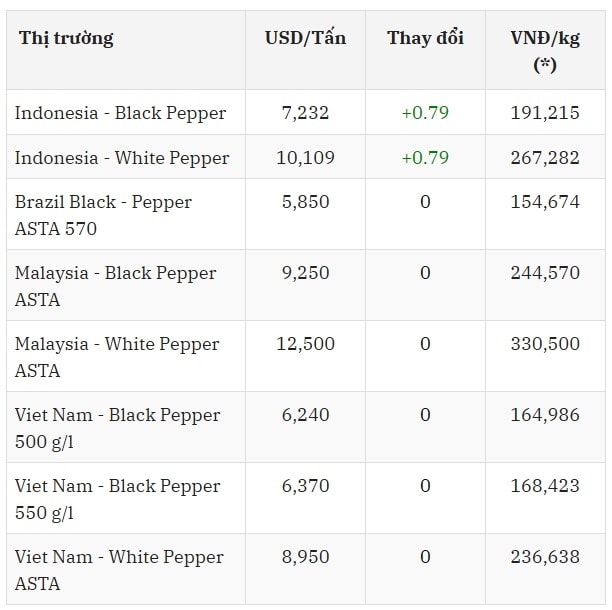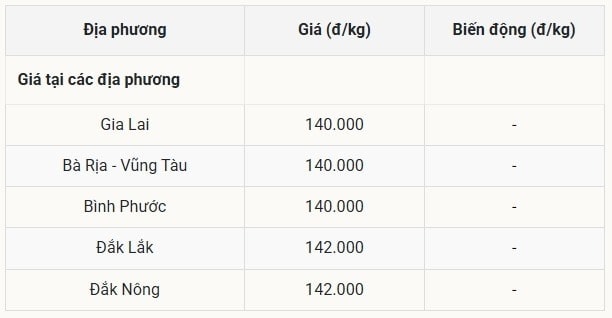Continue to increase at the weekend


In the world market
In the most recent trading session, Indonesian pepper prices slightly decreased, while other countries remained generally stable.
The International Pepper Community (IPC) quoted Indonesian black pepper at $7,129 per tonne, down 0.35% from the previous session.
Meanwhile, Malaysian ASTA black pepper remained stable at 9,600 USD/ton, while Brazilian ASTA 570 black pepper reached 6,000 USD/ton.
In Vietnam, the export price of black pepper still fluctuates from 6,240 - 6,370 USD/ton for 500 g/l and 550 g/l.
|
Type name |
World black pepper price list |
|
|
August 23 (Unit: USD/ton) |
% change from previous day |
|
|
Lampung Black Pepper (Indonesia) |
7.129 |
-0.35 |
|
Brazilian Black Pepper ASTA 570 |
6,000 |
– |
|
Kuching Black Pepper (Malaysia) ASTA |
9,600 |
– |
|
Vietnamese black pepper (500 g/l) |
6,240 |
– |
|
Vietnamese black pepper (500 g/l) |
6,370 |
– |
At the same time of survey, the price of Indonesian Muntok white pepper decreased by 0.35% compared to the previous day, reaching 9,996 USD/ton.
Malaysian ASTA white pepper was stable at USD 12,800/ton, while Vietnamese white pepper stood at USD 8,950/ton.
|
Type name |
World white pepper price list |
|
|
August 23 (Unit: USD/ton) |
% change from previous day |
|
|
Muntok Indonesian White Pepper |
9,996 |
-0.35 |
|
ASTA Malaysian White Pepper |
12,800 |
– |
|
Vietnam white pepper |
8,950 |
– |
Update pepper information
According to Gia Lai Newspaper, to anticipate market demand and increase income, some farmers in the western communes of Gia Lai province have boldly switched to growing green pepper in the off-season. This direction not only increases the value of the crop but also helps farmers proactively adapt to market fluctuations.
The idea of growing off-season pepper was hatched by Mr. Cu Quoc Hung (village 6, Gao commune) in 2022. Mr. Hung said: Pepper prices have returned, so when planting new crops, he chose to grow Sri Lanka varieties, because of their outstanding growth ability, ease of care and high disease resistance. From researching and learning organic care techniques, combined with existing experience, he produces off-season green pepper by regulating irrigation water and fertilizing properly. Thanks to suitable soil, each pepper pole can harvest about 15 kg of fresh pepper to sell as green chains, while chains with lower fruit quality will be harvested and dried.
According to farmers, the technique applied to this new variety is to fertilize and water continuously to create good humidity so that the tree can produce fruit in batches and can be harvested year-round. Off-season products are mainly sold as green pepper chains to restaurants or resold to establishments that process pepper dishes such as pickled pepper and frozen pepper.
Off-season green pepper has a selling price 1.5 - 2 times higher than the main season and is currently fluctuating from 50,000 - 70,000 VND/kg. At some times in the time frame from April to July, it can reach 110 - 120 thousand VND/kg.
Realizing the increasing effectiveness of green pepper products, in addition to red pepper production, Gia Lai Red Pepper One Member Co., Ltd. (village 5, Kon Gang commune) has expanded the planting of about 4,000 pillars using Malaysian pepper varieties, and also provided seeds to dozens of people in the area to expand production linkages and consume off-season green pepper.
Mr. Tran Quang Son, Director of the Company, said: “Green pepper is usually harvested from August to October every year, then the remaining part is left to ripen, making black pepper or red pepper products. Growing green pepper not only makes the plant stronger but also brings high economic value.
In Kon Gang commune, many households have started to switch to growing new pepper varieties and applying the off-season planting model to improve efficiency. In the third year, pepper gardens have an average yield of about 12 kg fresh/pillar.
With the current productivity and selling price, each hectare of green pepper can earn a profit of 500 million VND/year or more, depending on the monoculture or intercropping method. The company has partners in the South who regularly purchase and export to Thailand, so the output is quite stable.
In the context of old varieties, used for many years, degenerating due to pests, diseases and the harsh impacts of climate change, many farmers have introduced new varieties into cultivation to increase productivity and quality of harvested products.
















Comment (0)